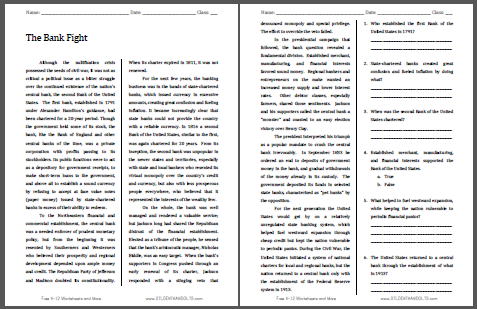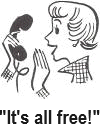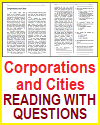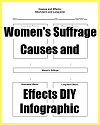| The Bank Fight Reading with Questions |
|---|
| www.studenthandouts.com ↣ American History ↣ American History Readings with Questions |
Although the nullification crisis possessed the seeds of civil war, it was not as critical a political issue as a bitter struggle over the continued existence of the nation's central bank, the second Bank of the United States. The first bank, established in 1791 under Alexander Hamilton's guidance, had been chartered for a 20-year period. Though the government held some of its stock, the bank, like the Bank of England and other central banks of the time, was a private corporation with profits passing to its stockholders. Its public functions were to act as a depository for government receipts, to make short-term loans to the government, and above all to establish a sound currency by refusing to accept at face value notes (paper money) issued by state-chartered banks in excess of their ability to redeem. To the Northeastern financial and commercial establishment, the central bank was a needed enforcer of prudent monetary policy, but from the beginning it was resented by Southerners and Westerners who believed their prosperity and regional development depended upon ample money and credit. The Republican Party of Jefferson and Madison doubted its constitutionality. When its charter expired in 1811, it was not renewed.
To the Northeastern financial and commercial establishment, the central bank was a needed enforcer of prudent monetary policy, but from the beginning it was resented by Southerners and Westerners who believed their prosperity and regional development depended upon ample money and credit. The Republican Party of Jefferson and Madison doubted its constitutionality. When its charter expired in 1811, it was not renewed.For the next few years, the banking business was in the hands of state-chartered banks, which issued currency in excessive amounts, creating great confusion and fueling inflation. It became increasingly clear that state banks could not provide the country with a reliable currency. In 1816 a second Bank of the United States, similar to the first, was again chartered for 20 years. From its inception, the second bank was unpopular in the newer states and territories, especially with state and local bankers who resented its virtual monopoly over the country's credit and currency, but also with less prosperous people everywhere, who believed that it represented the interests of the wealthy few. On the whole, the bank was well managed and rendered a valuable service; but Jackson long had shared the Republican distrust of the financial establishment. Elected as a tribune of the people, he sensed that the bank's aristocratic manager, Nicholas Biddle, was an easy target. When the bank's supporters in Congress pushed through an early renewal of its charter, Jackson responded with a stinging veto that denounced monopoly and special privilege. The effort to override the veto failed. In the presidential campaign that followed, the bank question revealed a fundamental division. Established merchant, manufacturing, and financial interests favored sound money. Regional bankers and entrepreneurs on the make wanted an increased money supply and lower interest rates. Other debtor classes, especially farmers, shared those sentiments. Jackson and his supporters called the central bank a "monster" and coasted to an easy election victory over Henry Clay. The president interpreted his triumph as a popular mandate to crush the central bank irrevocably. In September 1833 he ordered an end to deposits of government money in the bank, and gradual withdrawals of the money already in its custody. The government deposited its funds in selected state banks, characterized as "pet banks" by the opposition. For the next generation te United States would get by on a relatively unregulated state banking system, which helped fuel westward expansion through cheap credit but kept the nation vulnerable to periodic panics. During the Civil War, the United States initiated a system of national charters for local and regional banks, but the nation returned to a central bank only with the establishment of the Federal Reserve system in 1913. Answer Key: (1) Alexander Hamilton; (2) Issuing currency in excessive amounts; (3) 1816; (4) A -True; (5) Cheap credit from the unregulated state banking system; (6) Federal Reserve System. Click here to print. |
 |  |  |  |  |  |
| www.studenthandouts.com ↣ American History ↣ American History Readings with Questions |








